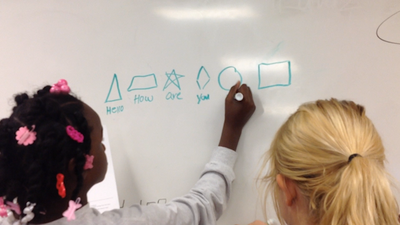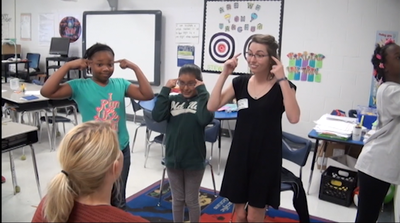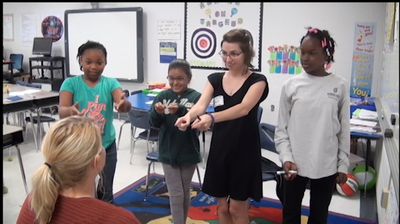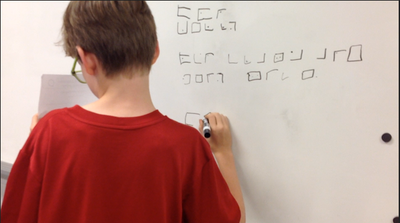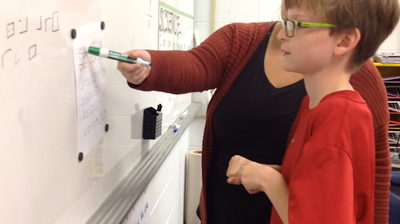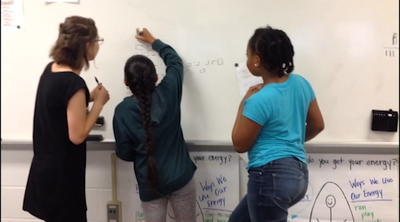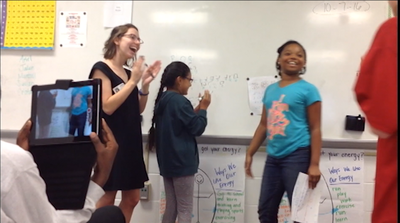Table of Contents
|
What's this lesson all about?
Students were asked to create a language for their clan and come up with a specific message to communicate to the class. First, they chose a mode of communication. One group, inspired by hieroglyphics, chose to create a series of pictographs, as well as creating a nonverbal language of gestures, and asked us, "How are you?" Meanwhile, the other clan came up with a code complete with a legend that would allow the rest of the class to translate it. That message read, "You are all awesome!" Each group took turns demonstrating their language while the rest of us attempted to guess what they were trying to communicate.
What is Language?
Before breaking for our activity, we first sat and discussed our major takeaways for this lesson. Students brainstormed all the different ways that they communicate and considered how their communication changes depending on who they are interacting with. Our first main point was that language is communication, and therefore can come in more than one form. Language can be written, depicted, verbal, nonverbal, and digital! People often communicate while using multiple modes simultaneously (i.e. gesturing while telling a story) and this helps to convey more complex messages. Our second main point was that language changes with context: our students communicate very differently with their friends than they do with their parents or teachers.
What is Language?
Before breaking for our activity, we first sat and discussed our major takeaways for this lesson. Students brainstormed all the different ways that they communicate and considered how their communication changes depending on who they are interacting with. Our first main point was that language is communication, and therefore can come in more than one form. Language can be written, depicted, verbal, nonverbal, and digital! People often communicate while using multiple modes simultaneously (i.e. gesturing while telling a story) and this helps to convey more complex messages. Our second main point was that language changes with context: our students communicate very differently with their friends than they do with their parents or teachers.
Videos
|
|
Creating a Clan Language Explained
This video features Kelly Likos talking about how she led the Clan Language lesson and what she wanted the students to take away from the activity. Hopefully this video will provide insight into why we made our lesson this way and what your students will learn from participating. |
|
|
|
Creating a Clan Language Lesson
This video is meant to give an in-depth look at our Creating a Clan Language lesson. This video includes: -Part of the lecture and how we use student centered teaching to get the students involved in what we're doing -How we deal with distractions in the classroom -The collaboration during the brainstorming part of the activity -How we perform the activity with the students |
|
|
|
Linguistic Anthropology Lesson
This video is an overview of the Linguistic Anthropology lesson given by Ms. Bree in Spring of 2018. Our powerpoint, lesson plan, Communication Charades activity, and lesson notes from this day can be found here (V1) |
Creating a Clan Language Lesson Plan (V2)
by Kelly Likos
Arcadia-Overview
Third, Fourth, and Fifth Graders
Lesson: Creating a Clan Language
Materials:
Review:
Focus:
Learning Objectives
Activity:
Arcadia-Overview
Third, Fourth, and Fifth Graders
Lesson: Creating a Clan Language
Materials:
- Paper
- Writing Utensils
Review:
- What is an artifact?
Focus:
- What is linguistic anthropology? How do anthropologists study language?
Learning Objectives
- Students will learn what linguistic anthropology is
- linguistic anthropology: the study of culture through language.
- Students will understand that language is communication and comes in many forms.
- Language is more than just spoken words.
- We can communicate the messages “yes,” “no,” “hi,” etc. without speaking by using gestures.
- Language can be written.
- In the age of technology this is becoming more and more common!
- People communicate with friends and loved ones from far away through text messages and emails.
- In the age of technology this is becoming more and more common!
- Language is more than just spoken words.
- Students will learn that we use language differently across situations.
- We speak differently depending on our role in a situation
- For example, students communicate differently with their teachers than with their friends.
- How you write a paper for your English class might be different from how you tell a story to your friends and family.
- We speak differently depending on our role in a situation
- Students will learn how anthropologists study language
- Anthropologists use a variety of methods for studying language
- Anthropologists sometimes study in places that don't speak the same language they do.
- They may use an interpreter if they don't know the language.
- They study gestures.
- For example: Someone saying "That's great!" while smiling means something different from the person saying "That's great!" while rolling their eyes.
- They study how people use language with different people.
- Anthropologists sometimes study in places that don't speak the same language they do.
- Anthropologists use a variety of methods for studying language
Activity:
- Students will divide into their clans. This week, they will be coming up with their own clan language! This can be written, verbal, symbol-based, or even just gestures. Students should pick a single phrase to keep it simple. At the end of the class, they will try and communicate their phrase to the other clans and see if they can help the other clans understand what they are saying.
- Our two clans chose non-verbal.
- One clan used gestures to communicate the phrase "How are you?"
- The other clan came up with a list of symbols and each symbol represented a different letter.
- The other clan was given the key to the language and had to translate their phrase.
- Their phrase was "you are all awesome!"
- Our two clans chose non-verbal.
Downloadable Content
|
| ||||||||||||||||||||||||
For more information and our own insider perspective on teaching Linguistics lessons, check out our blog!
Gallery
Below is a gallery of pictures from our lesson. In some of the pictures you can see the students writing their clan symbols on the board. In others, the students are using gestures to try and communicate their phrase to the other clan. One clan was asking "How are you?" and the other said "You are all awesome!"

